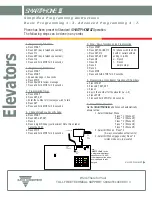
Setting Up Your System
85
NAT traversal is a general term for techniques that establish and maintain IP connections
traversing NAT gateways, typically required for client-to-client networking applications,
especially for VoIP deployments. STUN is one of the NAT traversal techniques supported by IP
phones.
STUN (Simple Traversal of UDP over NATs)
STUN is a network protocol, used in NAT traversal for applications of real-time voice, video,
messaging, and other interactive IP communications. The STUN protocol allows entities behind
a NAT to first discover the presence of a NAT and the type of NAT (for more information on the
NAT types, refer to
) and to obtain the mapped (public) IP address and
port number that the NAT has allocated for the UDP connections to remote parties. The
protocol requires assistance from a third-party network server (STUN server) usually located on
public Internet. The IP phone can be configured to act as a STUN client, to send exploratory
STUN messages to the STUN server. The STUN server uses those messages to determine the
public IP address and port used, and then informs the client.
Capturing packets after you enable the STUN feature, you can find that the IP phone sends
Binding Request to the STUN server, and then mapped IP address and port is placed in the
Binding Response: Binding Success Response MAPPED-ADDRESS: 59.61.92.59:19232.
SIP and TLS Source Ports for NAT Traversal
You can configure the SIP and TLS source ports on the IP Phone. Previously, the IP phone used
default values (5060 for UDP/TCP and 5061 for TLS). In the configuration files, you can use the
following parameters to configure the SIP and TLS source ports:
Local SIP Port
TLS SIP Port
If NAT is disabled, the port number shows in the Via and Contact SIP headers of SIP messages. If
NAT is enabled, the phone uses the NAT port number (and NAT IP address) in the Via and
Contact SIP headers of SIP messages, but still use the configured source port.
Summary of Contents for CP969
Page 1: ......
Page 22: ...Administrator s Guide for SIP T5 Series Smart Media Phones xxii ...
Page 30: ...Administrator s Guide for SIP T5 Series Smart Media Phones 8 ...
Page 474: ...Administrator s Guide for SIP T5 Series Smart Media Phones 452 ...
Page 781: ...Troubleshooting 759 The phone begins rebooting Any reboot of the phone may take a few minutes ...
Page 787: ...Troubleshooting 765 information on capturing packets refer to Capturing Packets on page 735 ...
Page 788: ...Administrator s Guide for SIP T5 Series Smart Media Phones 766 ...
Page 864: ...Administrator s Guide for SIP T5 Series Smart Media Phones 842 ...
















































